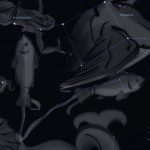| Meaning: | The Fishes | Print out the star map from Sky and Telescope
Things to look for: Messier objects: Note: [x.x] indicates visual magnitude |
|
| Pronunciation: | pie’ seez | ||
| Associated Asterisms: | The Circlet | ||
| % of the sky: | 2.16% | ||
| Visible Stars: | 50 stars brighter than magnitude 5.5 |

Pisces is the 14th largest constellation and contains both the 0hr line of Right Ascension and 0deg of Declination. This is because when setting the datums for measuring position in the sky, they choose the point where each Spring the path of the Sun crosses the projection of the Earth’s Equator onto space (the Celestial Equator). The path of the Sun runs through the constellation of Pisces, the so-called line of the ecliptic, and goes through the zero zero datum point around the 20th March each year, the vernal equinox. For those that enjoy reading their star signs, this point is the first point of Aries… although not in Aries as precession keeps the point slowly moving over time and renders all those predictions based on incorrect positions just entertainment.


Pisces is easily found cradling Pegasus in a large flambouyant V shape. Just below Pegasus, less than its own depth again, you find a ring of stars. This is the asterism of the Circlet of Pisces. It represents the head of one of the two fish and the joining rope that make up the constellation. In Greek mythology, the two fish represent the escape from Mount Olympus by Aphrodite and Eros during the attack by Typhon. Follow the line of stars to the East and downward to Alrischa, α Psc, at the appex of the V and then North towards Andromeda and M31. The second fish head is a less prominent isosceles triangle just below Mirach, β And.


There is one Messier object within the bounds of the constellations and it was designated M74. It has the name the Phantom Galaxy and is a face-on spiral galaxy of magnitude 9.6. The closest bright star to hop from is η Psc which is also the brightest star in the constellation. It is a good object in telescopes but also visible in good binoculars when backed up with a good dark sky. This is because it has a low surface brightness. The galaxy is similar in size to the Milky Way and consists of two spiral arms. A good target for the newbie astrophotographer starting out in the autumn.

Uranus is within Pisces and will be there for many months trundling through. It is currently demonstrating a retrograde loop as the Earth overtakes it and it appears to go backwards. The diagram to the left shows how it will move in this retrograde motion (left to right) from Oct to Nov 2017. It is magnitude 5.7 and visible both to the naked eye (in good skies) and with binoculars. Telescopes will show a disc and bigger aperture telescopes may be able to resolve some vague detail in the global weather system.


